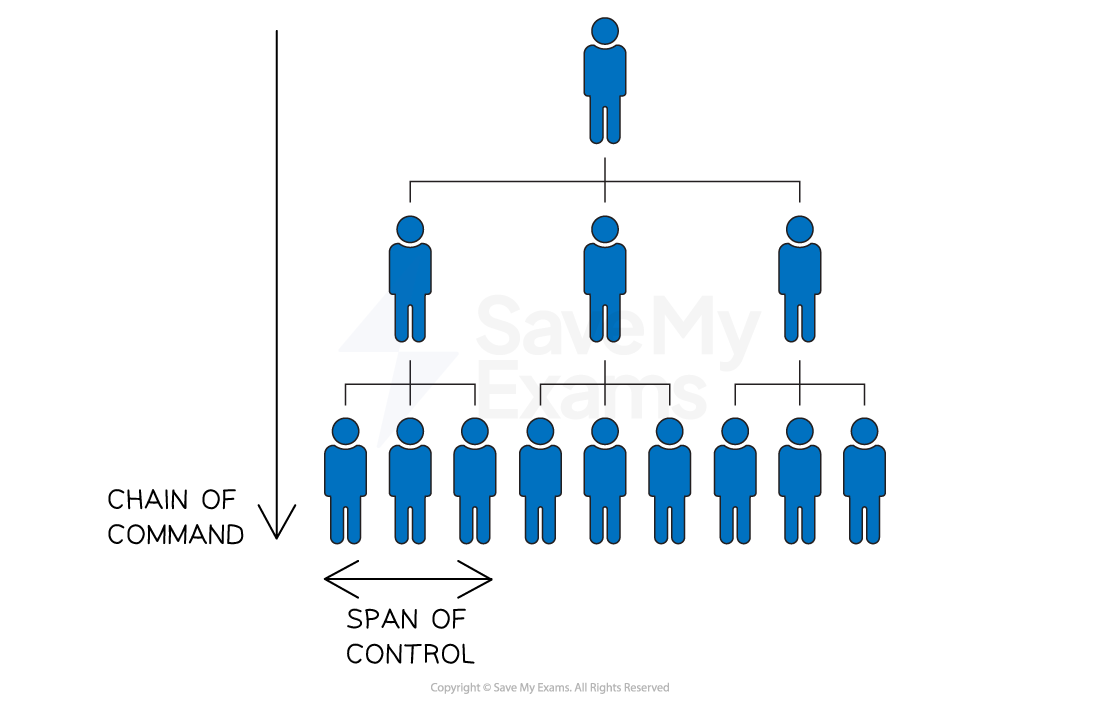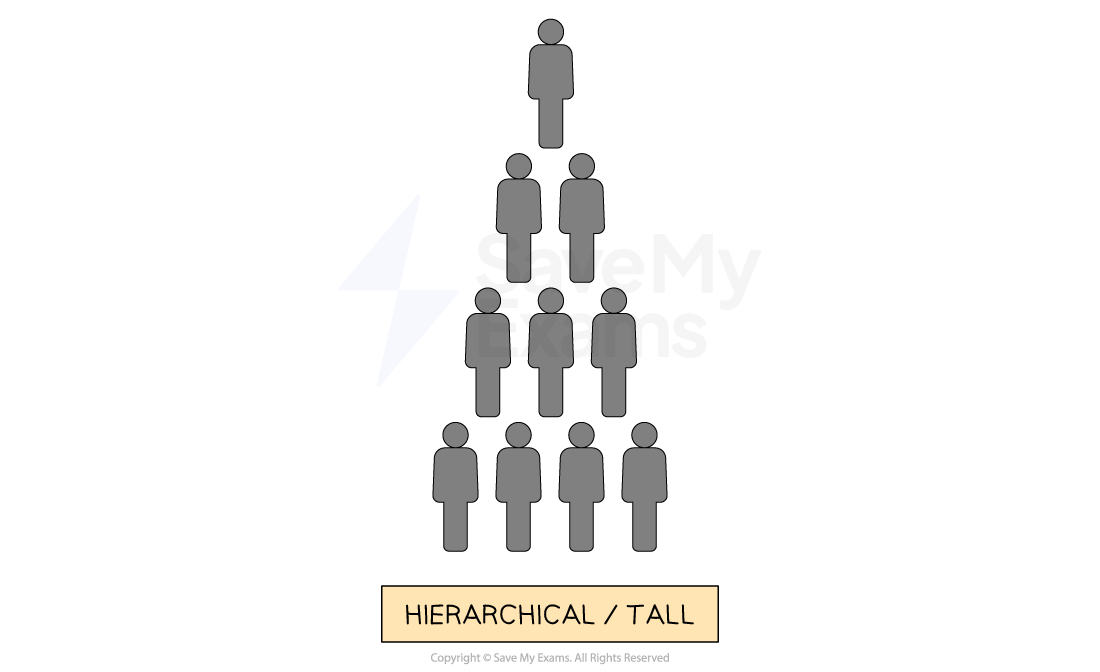Key Principles of Organisational Structures (AQA GCSE Business): Revision Note
Exam code: 8132
An introduction to organisational structures
An organisational structure outlines the reporting relationships, roles, and responsibilities of employees
Businesses need to choose a suitable structure to enable them to effectively implement ideas and achieve their objectives
They should consider how the structure may affect the management and effectiveness of operations and communication
A well-designed organisational structure helps to provide clarity, efficiency and accountability
It can be visually represented using an organisation chart
Organisational chart example

Examiner Tips and Tricks
In the exam, you may be asked to explain a reason for having an internal organisational structure. Explain questions, worth two marks, require you to make a correct point and develop it.
An example answer might look like this:
An internal structure allows a business to organise its workers [1] so that they know their roles in relation to others in the organisation [1].
Key terminology
Hierarchy
A hierarchy refers to the levels of authority within an organisation
It describes the ranking of positions from top to bottom
The higher the position in the hierarchy, the more authority and power it holds
The hierarchy usually includes top-level management, middle-level management, and lower-level employees
Chain of command
The chain of command is the formal line of authority that flows downward from top management to lower-level employees
It defines who reports to whom and who is responsible for making decisions
The chain of command helps to establish a clear communication channel and helps to maintain accountability within the organisation
Span of control
The span of control refers to the number of employees that a manager or supervisor directly manages
It is based on the principle that a manager can only effectively manage a limited number of employees
A narrower span of control means that there are more layers of management
A wider span of control means that there are fewer layers of management
Types of organisational structures
Organisational structures can be tall or flat
Tall organisational structure
A long chain of command usually results in a narrow span of control
Tall structures have multiple levels of management
Common in large organisations with complex operations
E.g. Government agencies and universities

Flat organisational structure
A short chain of command usually results in a wide span of control
Flat structures have few levels of management
Common in small organisations or start-ups
E.g. tech start-ups and small businesses

Evaluation of tall and flat structures
Structure | Advantages | Disadvantages |
|---|---|---|
Tall |
|
|
Flat |
|
|
Delayering
Delayering is the process of flattening tall organisational structures by removing one or more levels of hierarchy
It usually involves making middle management redundancies or choosing not to replace managers who leave
Benefits of delayering include:
Communication is likely to improve
Significant cost savings can be made as fewer management salaries need to be paid
However, some drawbacks include
Delayering can increase the workload of other employees
Remaining managers' spans of control widen, affecting coordination
Centralisation and decentralisation
A centralised organisational structure is where authority for decision-making rests with senior management at the centre of a business
A decentralised structure is where authority for decision-making is delegated further down the hierarchy towards functional or middle managers
In reality, few businesses are wholly centralised or decentralised
In most businesses, strategic decisions are made by senior leaders, whilst operational decisions are delegated to functional areas and middle managers
Evaluation of centralised and decentralised organisational structures
Structure | Advantages | Disadvantages |
|---|---|---|
Centralised |
|
|
Decentralised |
|
|
The main job roles and responsibilities in business
The organisational structure of a business determines the roles, responsibilities and relationships between individuals in an organisation
Business roles

Type of role
Directors
Larger businesses often have a board of directors who make key strategic business decisions such as:
Implementing new corporate policies
Investment of retained profit and share capital
Growth objectives
The board normally consists of a senior employee from each department, officers (such as treasurer or secretary) and the owner or chief executive officer (CEO) of a business
Managers
Managers have many responsibilities in the business and help it to operate effectively on a day-to-day basis
Types of managers include senior and functional managers, line managers and supervisors
Roles and responsibilities of managers
Role | Responsibilities |
|---|---|
Senior manager |
|
Functional manager |
|
Supervisor / team leader |
|
Operational and support Staff
Operational staff complete tasks to which they are directed by their manager(s)
E.g. In a department store, operational staff include customer service representatives, sales assistants and security staff
Support staff assist with the non-core operations of a business
E.g. In a bank, support staff may include cleaners, IT technicians and human resources assistants
Delegation
Delegation is a process where responsibility for specific tasks is given to subordinates by managers
Delegation usually involves transferring authority from manager to subordinate
E.g. the Human Resources Director of a large company delegates authority for recruitment and training to the Recruitment and Training Manager
Delegation is particularly important in businesses with a flat organisational structure, where managers have wide spans of control
Advantages of delegation
Advantages for managers | Advantages for workers |
|---|---|
|
|
|
|
|
|
Despite its advantages, some managers are reluctant to delegate as they lose some control over decision-making
Managers may need support to be able to balance trust and control to delegate appropriate tasks effectively
Autocratic leaders may not be willing to give authority to others
Some managers may feel threatened by highly skilled subordinates seeking promotion
Examiner Tips and Tricks
This topic contains several important key terms that you need to be able to define clearly, as they are often the subject of multiple choice questions.

You've read 0 of your 5 free revision notes this week
Unlock more, it's free!
Did this page help you?